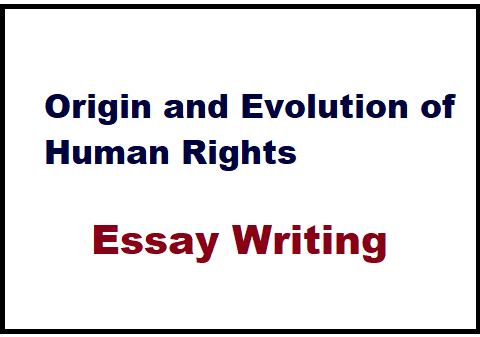Originating from ancient civilizations and evolving through various historical movements, human rights are universal principles that recognize inherent dignity and worth of every individual. From Magna Carta to Universal Declaration of Human Rights, journey of human rights is a testament to humanity’s collective pursuit of justice, equality, and freedom.

Essay on Origin and Evolution of Human Rights
Human rights are a set of rights that are inherent to all human beings, regardless of their race, gender, nationality, religion, or any other status. These rights include civil, political, economic, social, and cultural rights, and they are essential for protection and dignity of every individual. Concept of human rights has been evolving over time, and their origin can be traced back to ancient civilizations. Lets explore origin and evolution of human rights through this essay.
Origin of Human Rights
concept of human rights can be traced back to ancient civilizations, where certain rights were recognized and protected. For example, Code of Hammurabi, which was created by the Babylonian king Hammurabi in 1754 BC, recognized the right to life and the right to property. Similarly, the ancient Greeks recognized the right to a fair trial and the right to freedom of speech.
In the Middle Ages, the Magna Carta, which was signed by King John of England in 1215, recognized the rights of the barons and limited the power of the king. This document is considered to be the first written constitution and is a precursor to modern human rights instruments.
Enlightenment and Emergence of Modern Human Rights
The Enlightenment, which was a philosophical movement that originated in Europe in the 17th and 18th centuries, played a significant role in the development of modern human rights. Enlightenment thinkers such as John Locke, Jean-Jacques Rousseau, and Thomas Paine recognized the inherent rights of individuals and the need for a social contract between the people and the government.
The American and French Revolutions of the late 18th century were also important in the development of modern human rights. The United States Declaration of Independence, which was adopted in 1776, declared that “all men are created equal” and have the “unalienable rights” of “life, liberty, and the pursuit of happiness.”. The French Declaration of the Rights of Man and of the Citizen was adopted in 1789, which recognized the rights of individuals, including the right to liberty, property, security, and resistance to oppression.
Emergence of International Human Rights Instruments
In the aftermath of World War II, there was a growing recognition of the need for international human rights standards. The Universal Declaration of Human Rights, which was adopted by the United Nations General Assembly in 1948, is considered to be the cornerstone of modern human rights law. It recognized the inherent dignity and worth of every individual and established a set of rights that should be protected by all nations.
Since the adoption of the Universal Declaration of Human Rights, there have been numerous international treaties and agreements that have further elaborated on the rights and protections of individuals. These include the International Covenant on Civil and Political Rights, the International Covenant on Economic, Social and Cultural Rights, the Convention on the Rights of the Child, and the Convention on the Elimination of All Forms of Discrimination against Women, among others.
Evolution of Human Rights in Practice
While there have been significant developments in the recognition and protection of human rights, the realization of these rights in practice has been uneven. Discrimination, poverty, and political repression continue to be major challenges to the protection of human rights. Human rights violations continue to occur around the world, including in countries with established democratic institutions.
Nonetheless, there have been significant achievements in the protection of human rights. For example, the Civil Rights Movement in the United States in the 1950s and 1960s led to the passage of landmark civil rights legislation, including the Civil Rights Act of 1964, and, the Voting Rights Act of 1965. Similarly, the fall of apartheid in South Africa in the 1990s was a major victory for human rights.
Conclusion
In conclusion, the concept of human rights has evolved over time, from the recognition of certain rights in ancient civilizations to the development of modern human rights instruments. While there have been significant achievements in the protection of human rights, challenges remain in the realization of these rights in practice. Nonetheless, the recognition and protection of human rights remain essential for the dignity and well-being of every individual, and their evolution and development will continue to be an important issue in the years to come.
